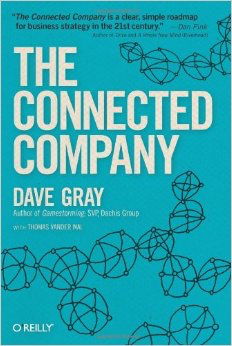As I read more about how to create organizations that are resilient and adaptable, there’s an interesting emergent characteristic. What I’m seeing is a particular pattern of structure that has arisen out of totally disparate areas, yet keeps repeating. While I haven’t had a chance to think about it at scale, like how it would manifest in a large organization, it certainly bears some strengths.
 Dave Grey, in his recent book The Connected Company that I reviewed, has argued for a ‘podular’ structure, where small groups of people are connected in larger aggregations, but work largely independently. He argues that each pod is a small business within the larger business, which gives flexibility and adaptiveness. Innovation, which tends to get stifled in a hierarchical structure, can flourish in this more flexible structure.
Dave Grey, in his recent book The Connected Company that I reviewed, has argued for a ‘podular’ structure, where small groups of people are connected in larger aggregations, but work largely independently. He argues that each pod is a small business within the larger business, which gives flexibility and adaptiveness. Innovation, which tends to get stifled in a hierarchical structure, can flourish in this more flexible structure.
 More recently, on Harold Jarche‘s recommendation, I read Niels Pflaeging’s Organize for Complexity, a book also on how to create organizations that are high performance. While I think the argument was a bit sketchy (to be fair, it’s deliberately graphic and lean), I was sold on the outcomes, and one of them is ‘cells’ composed of a small group of diverse individuals accomplishing a business outcome. He makes clear that this is not departments in a hierarchy, but flat communication between cross-functional teams.
More recently, on Harold Jarche‘s recommendation, I read Niels Pflaeging’s Organize for Complexity, a book also on how to create organizations that are high performance. While I think the argument was a bit sketchy (to be fair, it’s deliberately graphic and lean), I was sold on the outcomes, and one of them is ‘cells’ composed of a small group of diverse individuals accomplishing a business outcome. He makes clear that this is not departments in a hierarchy, but flat communication between cross-functional teams.
And, finally, Stan McChrystal has a book out called Team of Teams, that builds upon the concepts he presented as a keynote I mindmapped previously. This emerged from how the military had to learn to cope with rapid changes in tactics. Here again, the same concept of small groups working with a clear mission and freedom to pursue emerges.
This also aligns well with the results implied by Dan Pink’s Drive, where he suggests that the three critical elements for performance are to provide people with important goals, the freedom to pursue them, and support to succeed. Small teams fit well within what’s known about the best in getting the best ideas and solutions out of people, such as brainstorming.
These are nuances on top of Jon Husband’s Wirearchy, where we have some proposed structure around the connections. It’s clear that to become adaptive, we need to strengthen connections and decrease structure (interestingly, this also reflects the organizational equivalents of nature’s extremophiles). It’s about trust and purpose and collaboration and more. And, of course, to create a culture where learning is truly welcomed.
Interesting that out of responding to societal changes, organizational work, and military needs, we see a repeated pattern. As such, I think it’s worth taking notice. And there are clear L&D implications, I reckon. What say you?
#itashare